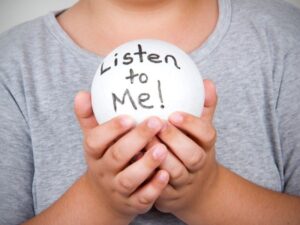
Relearning the Lost Art of Listening
I’m a counselor; it’s a job requirement to be a good listener. Sometimes I wonder how I landed this gig because I haven’t always been a good listener. Maybe I should’ve been a lawyer because what I lacked in listening, I gained in a knack for arguing. I don’t believe there’s anything wrong with disagreements, in fact they can be healthy in a relationship. The problem with arguing is that the emphasis can be more on winning than understanding. When we’re in a relationship with anyone, the goal is to stay in the relationship. “Winning” can erode it; “understanding” can build it. Enter: the need for listening.
Listening may sound super easy; after all you just listen, anyone can passively do it. Listening for the sake of truly understanding someone’s point of view, however, is active and requires intention. What’s the difference? It may look subtle, but the big difference is that the other person may feel heard, which can go a long way in resolving a disagreement or misunderstanding. How often have we been in discussions and watched the other person load their next reply before we even finished our sentence? It stinks being on either side of that conversation because we often just talk past each other. The road to good communication is paved with good listening. This requires discipline, patience, humility, and most of all, practice, because the first three traits don’t always come easy.
Effective, or “active listening,” is full body: squared up, hands down, eyes up kind of full body. In our hectic lives, this might be the hardest part, but it speaks volumes to our level of interest in the conversation. Body language matters. If I’m trying to communicate with someone who is walking around, turning their back, looking at their phone, etc., it’s a safe bet I don’t have their attention. How much better would our communication be, and by extension our relationships, if we stopped what we were doing and gave our full attention to one another? This is true of our spouses, kids, friends, family members, co-workers, and so on. Attention equals interest and respect.
A lot of miscommunications stem from failure to fully attend to a conversation to understand its meaning before rendering judgment on it. In most cases, pausing to clarify the context, intent, motive, and timing of someone’s comment can nip potential arguments in the bud. There’s actually a process for doing this that’s pretty easy:
- Give and request full attention while communicating. If you missed this, see above. Again, this part is hard because there can be all sorts of distractions. If they’re unavoidable, maybe consider pausing the conversation until there are fewer distractions. Timing can be important, especially if the conversation is serious. Additionally, if emotions are running high, take a break and come back later when things have cooled down. Effective communication is difficult, at best, when intense emotions are in play.
- Just listen. This is the part when mouths are closed and ears are open. This is also the part that may test our patience because this is not the time to interrupt, fix, agree, disagree, state our needs, or any other commentary. Listening does not mean conceding. The roles will switch and the other person will have to do the listening, too.
- Repeat what you heard. It may seem silly to parrot back what you just heard, but this is an important step because it tells the other person that you heard what they said. This is the time that misunderstandings can be clarified, or additional explanation can be given that may improve understanding. Not everyone can perfectly say how they feel the first time around, it may take a few tries. Again, this isn’t the time to judge the comments, it’s just repeating and clarifying.
- Restate and seek understanding. After clarifying their statements, ask if there is anything else that you need to know in order to better understand their position and what they need. Then you can reverse roles.
With time and practice, this can become second-nature and feel less awkward. You may be surprised just how well it can work, especially with our kids and teenagers. Practicing effective listening with our children, and spouses, will also provide a great model for them to follow. The more our kids know we’re listening, really listening, the more they’re likely to keep talking to us, which is reward enough.





